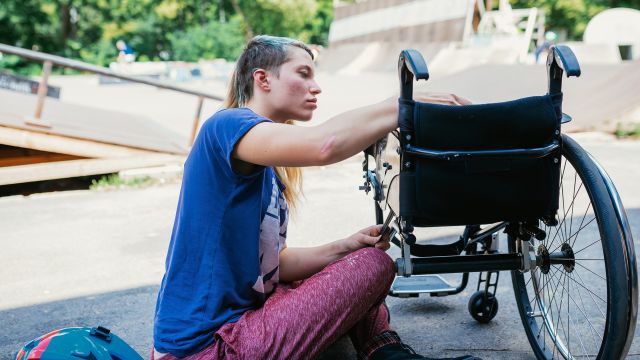Spinal muscular atrophy (SMA) is a disease that causes muscles to weaken and atrophy. There are different types, some of which are diagnosed at birth and some that are diagnosed later in life, but many people with the condition have it from a very young age.
SMA is a challenging condition to live with. It’s also a challenging condition for caregivers. And caregiving can be especially challenging as a person with SMA transitions from childhood to adolescence to young adulthood.
If you find yourself struggling to keep up with your evolving role as a caregiver, the following strategies may help.
Keep up with change
SMA is a lifelong condition, and the needs of a person with SMA will change over time. Likewise, a caregiver will find that their role will change—and sometimes change quickly. Being a freshman in high school and being a freshman in college are separated by only four or five years—but it is a period of rapid growth and development.
How do you keep up with change? Open lines of communication are important. While people with SMA have unique challenges and concerns, they also face the same challenges and concerns as any other young person. Don’t lose sight of the normal experience of growing up. Recognize a person’s needs, such as a greater need for privacy. Foster independence, such as encouraging a person to take a greater role in their own healthcare. Encourage good health, including exercise, eating well, and avoiding things like alcohol, smoking, and recreational drug use.
Also discuss your needs, and how to work together to support each other. For a young person living with SMA, being a source of support and encouragement for someone else can help foster a sense of independence.
And remember that you do not have to do this alone. Counselors, therapists, educators, and healthcare providers are there to help. And sometimes a young person may have an easier time talking to someone outside their family.
Recognize caregiver burnout
Caregiving is not easy, and caregiver burnout is very real. Caregiver burnout refers to feeling exhausted physically, mentally, and emotionally. Some signs and symptoms of caregiver burnout include:
- Skipping meals
- Feeling hopeless, restless, or anxious
- Avoiding phone calls with friends or frequently cancelling plans
- Difficulty going to sleep or staying asleep
- Physical aches and pains
- Feeling resentment toward the person for whom you’re caring
- Difficulty concentrating on tasks and chores
Remember, in order to provide the best care for someone else, you need to be taking care of yourself. Because things like nutrition and overall health are important to someone living with SMA, by taking care of yourself, you will be setting a good example.
Be proactive against stress
It’s important to recognize when you’re stressed and need a break. It’s even more beneficial to be proactive about reducing stress. Some ways to counteract stress include:
- Taking a day off to do something you enjoy—going for a hike, going to see a movie, meeting up with friends.
- Indulging every now and then, whether it is a dessert or a day at a spa.
- Working with a mental health professional—do not underestimate how helpful counseling and therapy can be.
- Getting enough sleep—consider turning off electronics an hour before bedtime and going to sleep at the same time every night.
- Staying organized and scheduling time to relax each day.
- Joining a support group for caregivers, where you can connect with other people who understand the experience.
- Also consider hiring a professional caregiver to handle some of the day-to-day responsibilities—and give you back some time and energy. There are apps and services that can connect you with professional caregivers (CareLinx by Sharecare is one example).
Remember that you are not superhuman. Ask other family members for help, and don’t be afraid to reach out to healthcare providers if you need guidance. Remember, you won’t be able to care for your loved one if you don’t take care of yourself.







